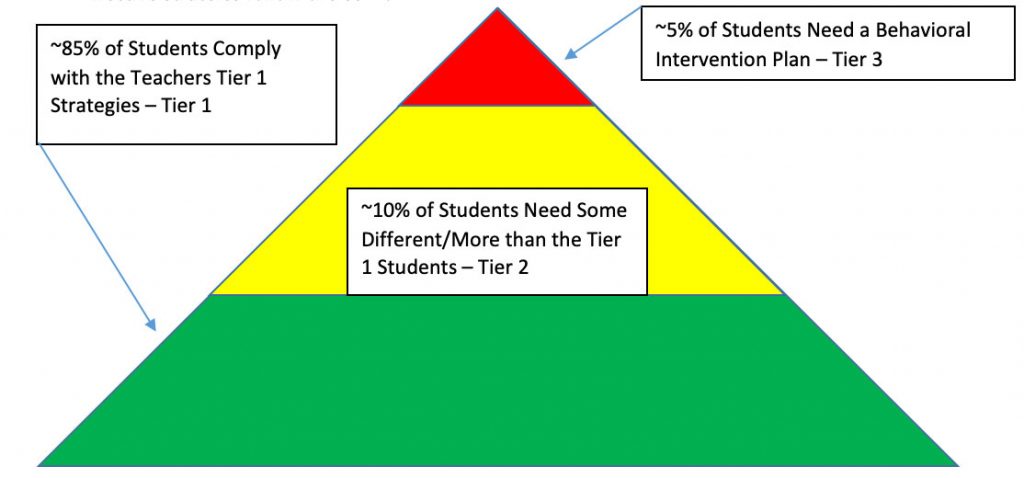Expand Your Tool Box: 5 Behavioral Strategies to Try Out Next Year
8/1/2019

Some of us have new tool boxes with just a few of the latest tools, some of us have large tool boxes that include everything we've collected over the years, but in either case, we should all be expanding our tool boxes with both new and old tools with proven results for different situations.
This proverbial tool box is ultimately the key to success for any educator. The number of strategies, tricks, and ideas a teacher uses with students is in direct correlation to both the student's success but also the teacher's.
Some teachers may only use a couple strategic approaches, and they may very well have been pretty successful for years. Unfortunately, when they encounter a student that doesn't respond to their typical strategies, behaviors can become stressful and possibly insurmountable to overcome.
With the rates of teacher burnout and turnover so high within the first couple years of a teaching career, educators and administrators alike must be proactive in building effective behavioral strategies, which means having a variety of trusty tools at hand. Principals must work to offer strong professional development opportunities for teachers, and teachers need to find as many tools as they can to meet their student's needs.
Building a tool box isn't just for new teachers. Teachers of all experience levels can benefit from expanding their toolbox. In fact, I believe and would argue that teachers today need a bigger variety of tools than they did twenty years ago. As we see problem behaviors increase in our schools, especially from trauma-affected students, we must expand our classroom management practices and strategies accordingly.
Having a growth mindset when understanding behavior is imperative. Great teachers know that their strategies for dealing with problem behaviors should be expanding every year as new students come into their classrooms, with the hope that they have a strategy that will work for every student.
Effective strategies follow the 85-10-5 triangle.

What a teacher brings every day to the classroom can be considered Tier 1 strategies. These are strategies that work for almost or all of the students on a consistent basis. Unfortunately, classroom management philosophies while I was in college were not discussed or taught. I am hoping colleges now have included such course work as a graduation requirement in teacher prep programs. For the most part, teachers get to implement their classroom management strategies when they start student teaching, and own it when they have their first classroom. As a student teacher, the mentor teacher probably has the largest impact and role in modeling classroom discipline.
The following are five of the most popular discipline and classroom management philosophies in education (I may be missing a few, but for the most part, this is an area in education we should be expanding):
- Assertive Discipline - Lee and Marlene Cantor - https://leecanter.weebly.com/
- Love and Logic - Jim Fay and Foster Cline - loveandlogic.com
- High Trust - Denny McLaughlin - hightrust.net
- Multiple Tiers of Systems of Support and Positive Behavior Intervention Systems pbis.org
- Restorative Practices - http://schottfoundation.org/restorative-practicesor https://www.iirp.edu/restorative-practices/what-is-restorative-practices
The best teachers beg, borrow, steal, and meld philosophies and strategies together with their own personal beliefs to create their own classroom culture.
Teachers can continue to expand their behavior toolbox and find strategies that both meld with their personal beliefs in classroom management, as well as stepping outside of the box to meet students in Tier 2 and Tier 3 behaviors.
Tier 2 behavior interventions are intended for a smaller subset of students. This is roughly 10% of the class. For a class of 30 students, a teacher may have to institute or implement strategies to support three or four students. As stated above, these students do not fit into the Tier 1 mold of classroom strategies…they need more or something different. A teacher can group these students together for small group behavior instruction or socio-emotional learning time. These students need direct instruction in one or more areas of socio-emotional learning deficits.
Tier 3 behavior interventions are intended for one or two students in a classroom of 30, or typically 5% of the student population. These behavior interventions can be more directed towards specific behaviors, as well as often requiring support from outside the classroom. These students usually have a behavior intervention plan (BIP), customized learning plan (CLP), or individualized education plan (IEP). These students typically have behavior that is more intense, longer in duration, or of a higher frequency than the Tier 2 behaviors. NOTE: I realize there are many factors that may necessitate more or fewer plans in your school. I am using numbers from a typical Response to Intervention Model triangle.
As we move from Tier 1, to Tier 2, and finally to Tier 3, the ability for a student to successfully regulate is typically the problem. A common solution is to support them through co-regulation strategies. Here are five of my favorite strategies that I have picked up from professional development and other professionals to support all tiers of behavior, but many times specifically helpful in supporting Tier 2 and 3 students.

1 - Brain Fuzz
The concept of getting a student's thought process changed or altered has been called many things over my career. For example, if a student is having a tantrum about not getting their way in the classroom, the teacher can start a conversation about something completely different. One of my favorite brain fuzz strategies is talking about puppies and what my puppy does at home, and another one is talking about my favorite pizza. Two things I can talk extensively on and have many funny stories I can elaborate on for hours, if need be!
Trying to change a student's train of thought can be difficult, but this strategy works with most students if you can find the right topic to "brain fuzz" the student. This is where relationships are a necessity. The better the teacher is at this strategy, most likely the student relationships are stronger. A strong teacher knows the student's interests and can use that to their advantage when using the brain fuzz strategy. For example, a student who likes the movie Transformers might be easily talked into a conversation about the Decepticons always losing. Thus, taking them out of their tantrum behaviors.
One of my good friends, Denny McLaughlin, who has developed a powerful and passionate educational philosophy called High Trust Psychology, coined the words for brain fuzz, "giving glass." When you give a student glass, you are trying to change their thinking by starting a conversation in order to divert their thought process. I believe it also is like giving the student a window into a different topic rather than being stuck in their negative train of thought.
Students may begin to start a rumination loop or continue to perseverate on negative thinking about themselves or others. In an article on Psychology Today, Christoper Bergland states, "In many ways, rumination is the opposite of savoring positive emotions. Another possible way to break apart the brain connectivity linked to depressive rumination might be daily practices…" We can give students something else to think about or do to break up this rumination cycle. We can give students practice using tools to change their train of thought. Brain fuzzing themselves is an actual strategy to get students to think about something different. They get to think of a different topic. As adults, isn't this what we do in order to change our thinking and not perseverate on a given topic.
Using "Brain Fuzz" or "Giving Glass" is an art form. This may sound funny, but start with an adult you know that gets upset often. Try the strategy with them. Then try the brain fuzz strategy with some of your students. You may find that it is easier to use with students!

2 - Check-In and Check Out
The check-in and check-out strategy has a couple common steps to it. First, the student checks in with the teacher. The teacher discusses the expectations for the upcoming time period (recess, class, lunch, etc.). The student restates what the expectations are for them. The student is dismissed and continues on to the next activity. At the end of the activity, the student checks back in with you.
The power of this strategy is what you do and say with the student in the check-in, as well as the follow through on the other end at the check-out. At the beginning of an intense behavior modification, teachers may even have to support during the activity between the check-in and check-out to co-regulate. NOTE: Co-regulate means that an adult supports the behavior regulation of the student during an activity.
Here are some quick tips for success with this strategy,
Check-In (Before Activity)
- Be specific with the student about the correct behavior that needs to be exhibited, as well as the specific expectations.
- Be specific with the behaviors that need to diminish or become extinct, and explain your rationale why it needs to stop ("It needs to stop for safety, for health, or for education).
- Discuss what strategies the student will use during the activity to be proactive and not exhibit the negative or unwanted behaviors.
- Have students repeat the expectations and what they will do when they encounter a difficult situation, and why they must do the activity correctly.
During Activity (Many times this is left out by teachers or left to the student to regulate)
- Decide if the student needs support to co-regulate during the activity.
- Model, practice, and pull the student to try again.
- Teach specifically the behaviors they can do with more success.
- Let them try it again.
- Repeat if necessary multiple times.
- Fade away with your support as the success increases.
Check-Out (Truly the accountability time)
- Ask the student how they did? Have them explain why with examples.
- Ask the student what they could do better the next time.
- Ask the student what it will take for them to fully regulate this activity on their own.
- Track the success on paper or with an app (pbis.org).
- Make sure to celebrate with the student and their parents/guardians.
- Continue until you have reached a goal, maybe 90% or 95% success for two weeks.
This can be a powerful strategy if used consistently, tracked for success, and giving time to celebrate small and large successes with the student. This strategy can be misinterpreted quite easy and even dismissed if it does not work right away. This is a strategy that can work if implemented over time. We must remember that some students need the same socio-emotional support 100 times as compared to their peers that might get it the first time.
3 - High Trust Language Techniques
If you have not heard of High Trust Psychology then you are missing out on a powerful philosophy that can lay the foundation for strong relationships. With hundreds of tips, strategies, and philosophical understandings that give specific words and actions, these strategies will transform your classroom, your communication with parents, colleagues, and even your own family. As stated above, "Giving Glass," is one strategy that can support students. Here are nine others you must check into and learn more about.
NOTE: I have paraphrased them to fit on one page. I am purposely only giving you some tasty morsels as I want you to check into Denny's workshops (contact information below).
| 1 | Four levels in influencing students
a. What is your job/responsibility? b. You may … c. You need to …. d. You can either ____ or you can choose me to support you. |
| 2 | Corrective Reinforcement:
1. Gently stop the behavior 2. Tell and show students a better way to fill their ARFF 3. Practice and CELEBRATE! |
| 3 | The correct way to explain "doing something"
We are ____ for (safety/health/education) and that is the correct thing to do." Stay away from using the word "right" because that can make it a moral issue. "We are buckling up for safety because it's the correct thing to do." |
| 4 | Front Loading
Front loading - prepare students before emotions kick in. ex: "When you're at our house, you can stay upstairs with the rest of the guests…" |
| 5 | Giving Effective Directions
a. What is your job? (if they can't remember, they can't do it) b. Have child repeat to teach them to listen the first time c. Child has a success by answering d. Last seen or heard is 2nd best remembered e. Hallways and open spaces radiate with courtesy, laughter and friendship |
| 6 | Model and Support for Success
Instead of punishing students, we model and support them in their successes. Teach to the rules - never punish with the rules. All rules need to be positive because you can only teach a positive, you cannot teach a negative. Rules are the spirit of the classroom and the procedures carry out the rules. Punishment is the infliction of pain for making a mistake. Pain can stop a behavior, but it cannot teach responsibility. |
| 7 | Sentence starters:
"To show more respect…" "For your success, you may…" "What is your job?" Also: Use the word "correct" in place of the word right. Using the word "right" makes it a moral issue rather than an expectation. |
| 8 | The 6 Valleys and the 2 Canyons
Valleys 1. Dangling Bait 2. Telling a kid what they did 3. Dealing with something in the past 4. Asking "why" 5. Dumb questions 6. Debit/Credit begging Canyons 1. Give it to me 2. To worry is to love/begging |
|
| 9 | Going to Solution
Those who blame lose the ability to change. In High Trust, energy always goes to the solution. The faster a person goes to solution, the healthier they are. |
|
If you would like to contact my friend, Denny McLaughlin, for a workshop done in your school, here is the information:
Denny McLaughlin
805-452-2303
www.hightrust.net
High Trust Thinking
Box 5712
Santa Barbara CA 93150

4 - Love and Logic SEL Banking Account
Another powerful philosophy to learn more about is Love and Logic. First developed in 1977 by Jim Fay and Foster Cline, it is a whole-child philosophy that is built around research-drive practices. It can be used, much like High Trust, with students, colleagues, parents, and even your own family. As stated on their website, www.loveandlogic.com:
The Love and Logic Institute is dedicated to making parenting and teaching fun and rewarding, instead of stressful and chaotic. We provide practical tools and techniques that help adults achieve respectful, healthy relationships with children. All of our work in based on a psychologically sound parenting and teaching philosophy called Love and Logic.
One of the strategies that I have used the most with students, families, and colleagues is the use of a metaphorical bank account. The basic premise is that students have a bank account that can be deposited into or withdrawn from according to their socio-emotional status. When I want to make a withdrawal from a student (or change a behavior), I need to make sure I have made some deposits (or have had some positive interactions prior). This concept can be used with all relationships. We must think about how we can be proactive to make multiple deposits in order to have a strong enough relationship to make a withdrawal.
There are a multitude of other strategies and tools you will find at the website listed above.

5 - Restorative Practices
The concept of restorative practices has been the latest buzz word in the past five years in educational practices. The premise of the philosophy is to make sure the relationships are sustained, fixed, and intact. As educators, when we keep that as our number one priority, we can change the consequences, re-teaching, modeling, and culture of a school.
The Schott Foundation has developed a powerful tool kit that I have started to make our own in our school. This tool kit can be useful for you in your understanding of what it might look like in your school. In the guide titled, "The Restorative Practices: Fostering Healthy Relationships & Promoting Positive Discipline in Schools A Guide for Educators," it states the following,
Restorative practices allow individuals who may have committed harm to take full responsibility for their behavior by addressing the individual(s) affected by the behavior. Taking responsibility requires understanding how the behavior affected others, acknowledging that the behavior was harmful to others, taking action to repair the harm, and making changes necessary to avoid such behavior in the future.
Restorative practices have changed how we handle discipline in our school. When we hurt someone or are disrespectful to someone, we always make sure we go back and fix the relationship first. We discuss the importance of maintaining the relationship and rationale behind why we must fix and repair it. As educators we help support the victim and the student who hurt them through a conversation with one and another. The victim gets to share with the other person how they were harmed. The student who harmed the student gets to discuss and show how they will resolve the harm caused.
The ability for students to fix a mistake needs support from adults. Adults may support both the victim and the student who harmed. Many times the adult will give words and model actions that the victim can do to make sure they are able to first stand up for themselves, but second to explain how they were harmed, as well as accepting an apology if needed. Then the adult can support the student repairing with positive words and actions.
A common misconception is that if the student is able to verbalize an apology and own their actions, then the student is off the hook for responsibility. For example, if a student were to punch another student, a simple apology with ownership should not be the final solution. With restorative practices, the fixing the relationship is done first, but the adult may have other consequences or discipline that is implemented. This is where Restorative Practices takes a hit from educators. The consequences may look different, but completely throwing out all consequences that have been working to stop unwanted behaviors is not necessarily needed.
In the above scenario, where a student punched another student, that student may have in-school suspension, may be off the playground until they are ready to regulate themselves, or may even need co-regulation with an adult for a time period. The idea is to give students the words and actions to fix relationships, take ownership, and be able to regulate their own behavior.
Restorative justice is used to reduce expulsions, suspensions, and disciplinary referrals. Again, the goal is to place value on relationships and focus on repairing relationships.
- Learning How to Say No and Set Boundaries with Parents - November 21, 2022
- If You Had Only One Behavior Strategy to Use in Your Classroom, What Would It Be? - September 26, 2022
- Live Your Code: 7 Strategies That Will Help You Be the Most Effective Educator You Can Be - August 15, 2022











